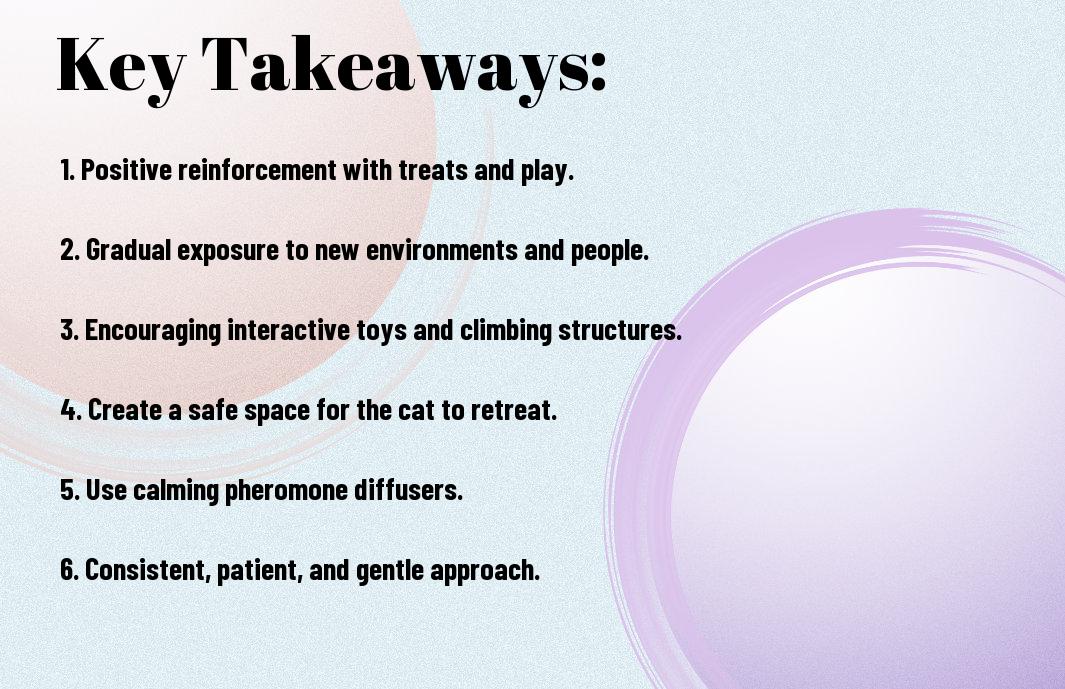Have you ever wondered how you can help your timid kitty gain more confidence? Cats, by nature, can be skittish and fearful, but there are simple techniques you can implement to help them feel more secure in their environment. From creating a safe space to encouraging play and socialization, there are several methods you can use to build your cat’s confidence and help them lead a happier, more fulfilling life. In this blog post, we will explore some tricks and tips for training your cat to be more confident.
Key Takeaways:
- Positive Reinforcement: Use treats, praise, and playtime to reward confident behavior in your cat.
- Creating a Safe Environment: Provide hiding spots, high places, and scratching posts to help your cat feel secure in their environment.
- Gradual Exposure: Slowly introduce new experiences and people to your cat to build their confidence over time.
- Regular Play and Exercise: Engage in interactive play and provide stimulating toys to help your cat release excess energy and build confidence.
- Consistency and Patience: Be consistent in your training methods and be patient as building confidence in a cat takes time and effort.


 Establishing a Trusting Relationship
Establishing a Trusting Relationship
Any successful training begins with establishing a trusting relationship between you and your cat. Cats are sensitive animals and need to feel safe and secure in their environment in order to build confidence. Creating a trusting bond with your cat is crucial to helping them become more confident. Taking the time to develop this relationship will set the foundation for successful training.
Consistent Positive Interactions
Consistent Positive Interactions
Consistent positive interactions with your cat are essential for building trust and confidence. Regularly engaging in activities that your cat enjoys, such as playtime, grooming, or simply spending quality time together, will help strengthen your bond. These positive interactions will show your cat that they can trust you, leading to increased confidence in their interactions with you and their surroundings.
Respect for the Cat’s Space and Boundaries
Respect for the Cat’s Space and Boundaries
Respecting your cat’s space and boundaries is crucial for establishing trust. Giving your cat the freedom to approach and interact with you on their terms shows respect for their individual needs and preferences. Avoid forcing them into situations they are uncomfortable with and honoring their personal space will help build a trusting relationship and ultimately increase their confidence.
Environmental Enrichment Strategies
After establishing the importance of a enriched environment for your cat’s confidence, it is time to implement some specific strategies in your home. Environmental enrichment is a key element in building confidence in cats and can lead to a more content and well-adjusted pet. By providing a stimulating and secure environment, you can help your cat build their confidence and reduce stress and anxiety.
The Role of Safe Havens
One important strategy for boosting your cat’s confidence is to provide them with safe havens within your home. These are areas where they can retreat to when they feel stressed or overwhelmed. Safe havens can take the form of cozy hiding spots, cat trees, or even designated rooms where your cat can feel secure. By giving your cat their own space, you are offering them a sense of security and control, which can help them build their confidence.
Stimulating Confidence through Play
Another way to boost your cat’s confidence is to engage them in regular play sessions. Play is not only fun for your cat, but it also helps them to build their confidence and develop their natural instincts. Interactive play with toys like feather wands or laser pointers can help your cat feel more in control and confident in their environment. Additionally, playing with your cat can strengthen the bond between you and your pet, further contributing to their overall sense of security and confidence.
Socialization and Exposure Techniques
However, socialization and exposure to new experiences are vital for building your cat’s confidence. By gradually introducing your cat to new people, animals, environments, and stimuli, you can help them become more comfortable and secure in various situations.
Gradual Introduction to New Experiences
When introducing your cat to new experiences, start small and gradually increase exposure. For example, if your cat is anxious around new people, you can start by having visitors over for short periods and gradually extending the time. This gradual approach allows your cat to adjust at their own pace, avoiding overwhelming them with new experiences.
Positive Reinforcement and Treat Rewards
Using positive reinforcement and treat rewards can be highly effective in building your cat’s confidence. When your cat exhibits more confident behavior, such as approaching new people or exploring a new environment, be sure to provide plenty of praise and treats. This positive reinforcement helps to associate new experiences with positive outcomes, encouraging your cat to be more confident in similar situations in the future.
Handling Setbacks and Progress
Despite your best efforts, it’s important to acknowledge that setbacks may occur when training your cat to be more confident. This is a normal part of the process, and it’s crucial to remain patient and persistent. Remember that building your cat’s confidence is a gradual process, and progress may not always be linear. When setbacks occur, it’s essential to stay calm and continue using positive reinforcement techniques to encourage your cat.
If you encounter challenges in your cat’s training, it may be helpful to seek additional resources and advice. Vetstreet offers valuable tips to help socialize a shy cat that can complement your training efforts and provide new strategies for overcoming setbacks.
Identifying Signs of Stress or Fear
It’s important to be able to recognize signs of stress or fear in your cat as you work to build their confidence. Some common indicators of stress in cats include excessive grooming, hiding, aggression, and changes in appetite or behavior. If you notice any of these signs, it’s essential to respond with patience and understanding, as pushing your cat too hard can exacerbate their anxiety.
Adjusting Training Approaches Accordingly
As you navigate the process of training your cat to be more confident, it’s crucial to be adaptable in your approach. Not all cats respond to the same training methods, so it’s important to observe your cat’s reactions and adjust your techniques accordingly. This may involve modifying the training environment, introducing new stimuli gradually, or seeking professional guidance if necessary.
The Key to Training a Confident Cat
The key to training a confident cat lies in providing a safe and secure environment, positive reinforcement, and patience. It is important to give your cat opportunities to explore and play, as well as offering praise and treats for brave behaviors. Additionally, creating routines and consistent interactions can help your cat feel more secure and confident in their surroundings. Remember, every cat is unique, so finding what works best for your feline friend may take time and experimentation. But with dedication and a positive attitude, you can help your cat become more confident and comfortable in their own skin.
FAQ
Q: How can I train my cat to be more confident?
A: There are several tricks you can use to help your cat build confidence. One effective method is to provide lots of positive reinforcement, such as treats and praise, when your cat exhibits confident behavior. Additionally, creating a safe and enriching environment for your cat to explore and play in can help boost their confidence. Lastly, regularly engaging in interactive play sessions with your cat can help them feel more secure and self-assured.
Q: What are some ways to build a cat’s self-assurance through training?
A: One way to build your cat’s self-assurance through training is by teaching them new tricks and skills. By using clicker training or positive reinforcement, you can help your cat feel more capable and confident. Another method is desensitization, where you gradually expose your cat to feared situations or environments in a controlled and positive way, helping them build confidence over time.
Q: How long does it typically take to train a cat to be more confident?
A: The timeline for training a cat to be more confident can vary depending on the individual cat and the methods used. Some cats may show improvement in their confidence within a few weeks, while others may take several months to see significant progress. Consistency and patience are key when training a cat, as each cat will have their own pace for building confidence.

Jayley, a devoted cat enthusiast, also writer for other cat blog as well. She aims to dedicated to providing comprehensive information, insights, and advice on everything you’d ever want to know about our whiskered companions.
